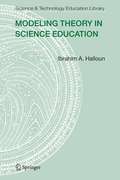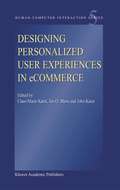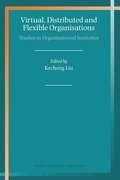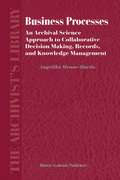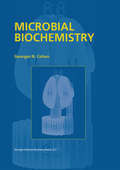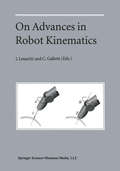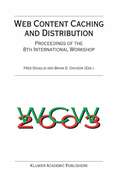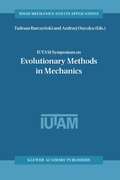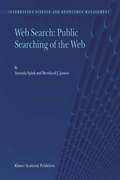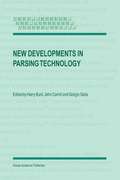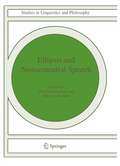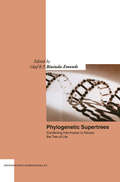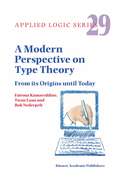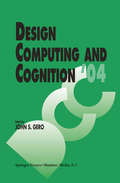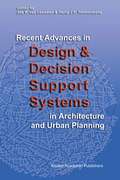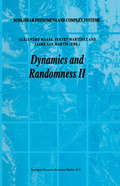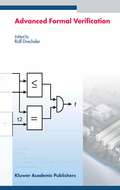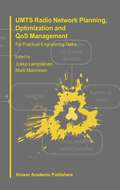- Table View
- List View
Exponential Fitting (Mathematics and Its Applications #568)
by Liviu Gr. Ixaru Guido Vanden BergheExponential Fitting is a procedure for an efficient numerical approach of functions consisting of weighted sums of exponential, trigonometric or hyperbolic functions with slowly varying weight functions. This book is the first one devoted to this subject. Operations on the functions described above like numerical differentiation, quadrature, interpolation or solving ordinary differential equations whose solution is of this type, are of real interest nowadays in many phenomena as oscillations, vibrations, rotations, or wave propagation.The authors studied the field for many years and contributed to it. Since the total number of papers accumulated so far in this field exceeds 200 and the fact that these papers are spread over journals with various profiles (such as applied mathematics, computer science, computational physics and chemistry) it was time to compact and to systematically present this vast material.In this book, a series of aspects is covered, ranging from the theory of the procedure up to direct applications and sometimes including ready to use programs. The book can also be used as a textbook for graduate students.
Modeling Theory in Science Education (Contemporary Trends and Issues in Science Education #24)
by Ibrahim A. HallounThis book is the culmination of over twenty years of work toward a pedagogical theory that promotes experiential learning of model-laden theory and inquiry in science. The book focuses as much on course content as on instruction and learning methodology, presenting practical aspects that have repeatedly demonstrated their value in fostering meaningful and equitable learning of physics and other science courses at the secondary school and college levels.
Designing Personalized User Experiences in eCommerce (Human–Computer Interaction Series #5)
by Clare-Marie Karat Jan O. Blom John KaratHow do you design personalized user experiences that delight and provide value to the customers of an eCommerce site? Personalization does not guarantee high quality user experience: a personalized user experience has the best chance of success if it is developed using a set of best practices in HCI. In this book 35 experts from academia, industry and government focus on issues in the design of personalized web sites. The topics range from the design and evaluation of user interfaces and tools to information architecture and computer programming related to commercial web sites. The book covers four main areas:-Theoretical, Conceptual, and Architectural Frameworks of Personalization, -Research on the Design and Evaluation of Personalized User Experiences in Different Domains, -Approaches to personalization Through Recommender Systems, -Lessons Learned and Future Research Questions. This book will be a valuable tool in helping the reader to understand the range of factors to take into consideration in designing and building a personalized user experience. The authors of each of the chapters identify possibilities and alert the reader to issues that can be addressed in the beginning of a project by taking a 'big picture' view of designing personalized user interfaces. For anyone working or studying in the field of HCI, information architecture or eCommerce, this book will provide a solid foundation of knowledge and prepare for the challenges ahead.
Virtual, Distributed and Flexible Organisations: Studies in Organisational Semiotics
by Kecheng LiuOrganisational Semiotics offers an effective approach to analysing organisations and modelling organisational behaviour. The methods and techniques derived from Organisational Semiotics enable us to study the organisation by examining how information is created and used for communication, coordination and performance of actions towards organisational objectives. The latest development of the young discipline and its applications have been reported in this book, which provides a useful guide and a valuable reference to anyone working in the areas of organisational study and information systems development.
Personalized Digital Television: Targeting Programs to Individual Viewers (Human–Computer Interaction Series #6)
by Liliana Ardissono Alfred Kobsa Mark T. MayburyTV viewers today are exposed to overwhelming amounts of information, and challenged by the plethora of interactive functionality provided by current set-top boxes. To ensure broad adoption of this technology by consumers, future Digital Television will have to take usability issues thoroughly into account. In particular, serious attention must be paid to facilitate the selection of content on an individual basis, and to provide easy-to-use interfaces that satisfy viewers' interaction requirements. This volume collects selected research reports on the development of personalized services for Interactive TV. Drawing upon contributions from academia and industry in the US, Europe and Asia, this book represents a comprehensive picture of leading edge research in personalized television.
Business Processes: An Archival Science Approach to Collaborative Decision Making, Records, and Knowledge Management (The Archivist's Library #3)
by Angelika Menne-HaritzCollaborative decision making processes are a form of communication inside organizations. Their functioning can teach lessons for the design of electronic office systems. Those processes are open ended and therefore decide themselves on their form. Like oral deliberations which cannot be modelled in advance any open ended communication process needs means for common control over the further advancement and the ending of the process. The history of German administrative practice and its special methods of using disposals for the control of common processes shows the creation of records as based on communication needs generated by the intention of joint actions. For electronic decision making processes the purposes remain the same, but the means have to follow the effects of electronic communication on messages. The book is a reworked English version of a thesis for the official qualification for university professorship accepted by the German University of Administrative Sciences Speyer. Germany.
Audiophotography: Bringing Photos to Life with Sounds (Computer Supported Cooperative Work #3)
by David M. FrohlichIf you read the history of any new communication medium such as the cinema, television or radio, it always happens to be bound up with advances in some underlying technology. For example, cinema was born out of the rapid projection of a series of still images on a celluloid film strip. The difficulty of synchronizing sound recordings with the resulting moving images led to about 30 years of silent films - until such time as the technical problems were solved. In between the inventions, media seem to grow and develop at a slower pace, as content producers and consumers experiment with the most satisfactory and stimulating ways of communicating with each other. In the same example, silent film-makers eventually found ways of adding dialogue through scene titles and having music played during the projection of their films. This book is about the next chapter in the history of photography, which is emerging from a relatively stable period into a chaos of new inventions. Photography as we know it is at the same point as the silent films of 1926. The transition from analog to digital photography is spawning many new ways of taking, manipulating and sharing photographs. It is also bringing photography and videography closer together by unifying sound, still and moving images in the same digital medium.
Microbial Biochemistry
by G.N. CohenMicrobial physiology, biochemistry, and genetics allowed the formulation of concepts that turned out to be important in the study of higher organisms. In the first section, the principles of bacterial growth are given, as well as the description of the different layers that enclose the bacterial cytoplasm, and their role in obtaining nutrients from the outside media through different permeability mechanism described in detail. A chapter is devoted to allostery and is indispensable for the comprehension of many regulatory mechanisms described throughout the book. Another section analyses the mechanisms by which cells obtain the energy necessary for their growth, glycolysis, the pentose phosphate pathway, the tricarboxylic and the anaplerotic cycles. Two chapters are devoted to classes of microorganisms rarely dealt with in textbooks, namely the Archaea, mainly the methanogenic bacteria, and the methylotrophs. Eight chapters describe the principles of the regulations at the transcriptional level, with the necessary knowledge of the machineries of transcription and translation. The next fifteen chapters deal with the biosynthesis of the cell building blocks, amino acids, purine and pyrimidine nucleotides and deoxynucleotides, water-soluble vitamins and coenzymes, isoprene and tetrapyrrole derivatives and vitamin B12. The two last chapters are devoted to the study of protein-DNA interactions and to the evolution of biosynthetic pathways. The considerable advances made in the last thirty years in the field by the introduction of gene cloning and sequencing and by the exponential development of physical methods such as X-ray crystallography or nuclear magnetic resonance have helped presenting metabolism under a multidisciplinary attractive angle. The level of readership presupposes some knowledge of chemistry and genetics at the undergraduate level. The target group is graduate students, researchers in Academia and industry.
On Advances in Robot Kinematics
by C. Galletti Jadran Lenar 269 I 269In the last decade, we have seen an extraordinary progress in the the ory and applications of robot kinematics. This has been motivated espe cially by the development of complex parallel and humanoid robots. The present book reports the most recent research advances in the theory, design, control and application of robotic systems, which are intended for a variety of purposes such as manipulation, manufacturing, automa tion, surgery, locomotion and biomechanics. The issues addressed are fundamentally kinematic in nature, including synthesis, calibration, re dundancy, force control, dexterity, inverse and forward kinematics, kine matic singularities, as well as over-constrained systems. Methods used include line geometry, quaternion algebra, screw algebra, and linear alge bra. These methods are applied to both parallel and serial multi-degree of-freedom systems. The results should interest researchers, teachers and students, in fields of engineering and mathematics related to robot theory, design, control and application. This is the sixth book of the series Advances in Robot Kinematics published by Kluwer. The contributions in this book had been rigorously reviewed by in dependent reviewers and fifty one articles had been recommended for publication. They were introduced in seven chapters. These articles were also reported and discussed at the ninth international symposium on Advances in Robot Kinematics which was held in June 2004 in Sestri Levante in Italy.Indexed in Conference Proceedings Citation Index- Science (CPCI-S)
Web Content Caching and Distribution: Proceedings of the 8th International Workshop (Ifip International Federation For Information Processing Ser.)
by Brian D. Davison Fred DouglisWeb caching and content delivery technologies provide the infrastructure on which systems are built for the scalable distribution of information. This proceedings of the eighth annual workshop, captures a cross-section of the latest issues and techniques of interest to network architects and researchers in large-scale content delivery. Topics covered include the distribution of streaming multimedia, edge caching and computation, multicast, delivery of dynamic content, enterprise content delivery, streaming proxies and servers, content transcoding, replication and caching strategies, peer-to-peer content delivery, and Web prefetching. Web Content Caching and Distribution encompasses all areas relating to the intersection of storage and networking for Internet content services. The book is divided into eight parts: mobility, applications, architectures, multimedia, customization, peer-to-peer, performance and measurement, and delta encoding.
Nonlinear Physical Oceanography: A Dynamical Systems Approach to the Large Scale Ocean Circulation and El Niño, (Atmospheric and Oceanographic Sciences Library #Vol. 28)
by Henk A. DijkstraTaken from a review of the first edition in SIAM: "This text is different from most others in that it combines several different disciplines and draws on many scientific studies in order to deduce mechanisms of ocean circulation. (…) Therefore (it) cannot be substituted, and (…) it meets its unique goals with clarity and thoroughness".
IUTAM Symposium on Evolutionary Methods in Mechanics: Proceedings of the IUTAM Symposium held in Cracow, Poland, 24–27 September, 2002 (Solid Mechanics and Its Applications #117)
by Tadeusz Burczynski Andrzej OsyczkaProceedings of the IUTAM Symposium held in Cracow, Poland, 24-27 September 2002
Web Search: Public Searching of the Web (Information Science and Knowledge Management #6)
by Amanda Spink Bernard J. JansenThis book brings together results from the Web search studies we conducted from 1997 through 2004. The aim of our studies has been twofold: to examine how the public at large searches the Web and to highlight trends in public Web searching. The eight-year period from 1997 to 2004 saw the beginnings and maturity of public Web searching. Commercial Web search engines have come and gone, or endured, through the fall of the dot.com companies. We saw the rise and, in some cases, the demise of several high profile, publicly available Web search engines. The study of the Web search is an exciting and important area of interdisciplinary research. Our book provides a valuable insight into the growth and development of human interaction with Web search engines. In this book, our focus is on the human aspect of the interaction between user and Web search engine. We do not investigate the Web search engines themselves or their constantly changing interfaces, algorithms and features. We focus on exploring the cognitive and user aspects of public Web searching in the aggregate. We use a variety of quantitative and qualitative methods within the overall methodology known as transaction log analysis.
New Developments in Parsing Technology (Text, Speech and Language Technology #23)
by H. Bunt John Carroll Giorgio SattaParsing can be defined as the decomposition of complex structures into their constituent parts, and parsing technology as the methods, the tools, and the software to parse automatically. Parsing is a central area of research in the automatic processing of human language. Parsers are being used in many application areas, for example question answering, extraction of information from text, speech recognition and understanding, and machine translation. New developments in parsing technology are thus widely applicable. This book contains contributions from many of today's leading researchers in the area of natural language parsing technology. The contributors describe their most recent work and a diverse range of techniques and results. This collection provides an excellent picture of the current state of affairs in this area. This volume is the third in a series of such collections, and its breadth of coverage should make it suitable both as an overview of the current state of the field for graduate students, and as a reference for established researchers.
Ellipsis and Nonsentential Speech (Studies in Linguistics and Philosophy #81)
by Reinaldo Elugardo Robert J. StaintonThe papers in this volume address two main topics: Q1: What is the nature, and especially the scope, of ellipsis in natural l- guage? Q2: What are the linguistic/philosophical implications of what one takes the nature/scope of ellipsis to be? As will emerge below, each of these main topics includes a large sub-part that deals speci?cally with nonsentential speech. Within the ?rst main topic, Q1, there arises the sub-issueofwhethernonsententialspeechfallswithinthescopeofellipsisornot;within the second main topic, Q2, there arises the sub-issue of what linguistic/philosophical implications follow, if nonsentential speech does/does not count as ellipsis. I. THE NATURE AND SCOPE OF ELLIPSIS A. General Issue: How Many Natural Kinds? There are many things to which the label ‘ellipsis’ can be readily applied. But it’s quite unclear whether all of them belong in a single natural kind. To explain, consider a view, assumed in Stainton (2000), Stainton (2004a), and elsewhere. It is the view that there are fundamentally (at least) three very different things that readily get called ‘ellipsis’, each belonging to a distinct kind. First, there is the very broad phenomenon of a speaker omitting information which the hearer is expected to make use of in interpreting an utterance. Included therein, possibly as a special case, is the use of an abbreviated form of speech, when one could have used a more explicit expression. (See Neale (2000) and Sellars (1954) for more on this idea.
Phylogenetic Supertrees: Combining information to reveal the Tree of Life (Computational Biology #4)
by Olaf R. P. Bininda-EmondsThis is the first book on "phylogenetic supertrees", a recent, but controversial development for inferring evolutionary trees. Rather than analyze the combined primary character data directly, supertree construction proceeds by combining the tree topologies derived from those data. This difference in strategy has allowed for the exciting possibility of larger, more complete phylogenies than are otherwise currently possible, with the potential to revolutionize evolutionarily-based research. This book provides a comprehensive look at supertrees, ranging from the methods used to build supertrees to the significance of supertrees to bioinformatic and biological research. Reviews of many the major supertree methods are provided and four new techniques, including a Bayesian implementation of supertrees, are described for the first time. The far-reaching impact of supertrees on biological research is highlighted both in general terms and through specific examples from diverse clades such as flowering plants, even-toed ungulates, and primates. The book also critically examines the many outstanding challenges and problem areas for this relatively new field, showing the way for supertree construction in the age of genomics. Interdisciplinary contributions from the majority of the leading authorities on supertree construction in all areas of the bioinformatic community (biology, computer sciences, and mathematics) will ensure that this book is a valuable reference with wide appeal to anyone interested in phylogenetic inference.
A Modern Perspective on Type Theory: From its Origins until Today (Applied Logic Series #29)
by F.D. Kamareddine T. Laan Rob NederpeltThis book provides an overview of type theory. The first part of the book is historical, yet at the same time, places historical systems in the modern setting. The second part deals with modern type theory as it developed since the 1940s, and with the role of propositions as types (or proofs as terms. The third part proposes new systems that bring more advantages together.
Systems Approaches and Their Application: Examples from Sweden
by Mats-Olov Olsson Gunnar SjöstedtThis book describes the application of systems thinking across a broad field of cases representing research, teaching, decision support and construction. All cases are presented by experts who have actually been involved in the activities they describe. The broad selection of cases captures the great variation of systems thinking, and how it is integrated into models and theories and solid knowledge pertaining to different substantive areas.
Design Computing and Cognition ’04
by Asko RiitahuhtaArtificial intelligence provides an environmentally rich paradigm within which design research based on computational constructions can be carried out. This has been one of the foundations for the developing field called "design computing". Recently, there has been a growing interest in what designers do when they design and how they use computational tools. This forms the basis of a newly emergent field called "design cognition" that draws partly on cognitive science. This new conference series aims to provide a bridge between the two fields of "design computing" and "design cognition". The papers in this volume are from the "First International Conference on Design Computing and Cognition" (DCC'04) held at the Massachusetts Institute of Technology, USA. They represent state-of-the art research and development in design computing and cognition. They are of particular interest to researchers, developers and users of advanced computation in design and those who need to gain a better understanding of designing.
Recent Advances in Design and Decision Support Systems in Architecture and Urban Planning (Studies In German Idealism Ser.)
by Jos P. Van Leeuwen Harry J. P. TimmermansDynamics and Randomness II: (pdf) (Nonlinear Phenomena and Complex Systems #10)
by Alejandro Maass Servet Martínez Jaime San MartínAdvanced Formal Verification
by Rolf DrechslerAdvanced Formal Verification shows the latest developments in the verification domain from the perspectives of the user and the developer. World leading experts describe the underlying methods of today's verification tools and describe various scenarios from industrial practice. In the first part of the book the core techniques of today's formal verification tools, such as SAT and BDDs are addressed. In addition, multipliers, which are known to be difficult, are studied. The second part gives insight in professional tools and the underlying methodology, such as property checking and assertion based verification. Finally, analog components have to be considered to cope with complete system on chip designs.
Design of Energy-Efficient Application-Specific Instruction Set Processors
by Tilman Glökler Heinrich MeyrAfter a brief introduction to low-power VLSI design, the design space of ASIP instruction set architectures (ISAs) is introduced with a special focus on important features for digital signal processing. Based on the degrees of freedom offered by this design space, a consistent ASIP design flow is proposed: this design flow starts with a given application and uses incremental optimization of the ASIP hardware, of ASIP coprocessors and of the ASIP software by using a top-down approach and by applying application-specific modifications on all levels of design hierarchy. A broad range of real-world signal processing applications serves as vehicle to illustrate each design decision and provides a hands-on approach to ASIP design. Finally, two complete case studies demonstrate the feasibility and the efficiency of the proposed methodology and quantitatively evaluate the benefits of ASIPs in an industrial context.
UMTS Radio Network Planning, Optimization and QOS Management: For Practical Engineering Tasks
by Jukka Lempiäinen Matti ManninenIn cellular networks, a new generation of CDMA or WCDMA-based networks will start operations in most countries in the near future. The standardized WCDMA technology generates new challenges in radio network planning, optimization and QoS management because of the dynamic nature of its radio interface and various new services and different network operating modes. Moreover, new and modified radio planning phases as well as new field measurements and emphasized QoS management are needed when UMTS networks are designed and optimized. Hence, a practical UMTS planning process must be defined in detail, from dimensioning to optimization tasks. This book follows the UMTS planning process. It is organized in three parts: Part I - UMTS configuration planning; Part II - UMTS topology planning; and Part III - UMTS network functionality. The first chapter in Part I introduces the UMTS and UTRAN systems and radio network planning strategy, and defines a planning process for UMTS. In Chapter 2, the UMTS planning process is covered, and a detailed description of the UMTS power budget is given, with planning threshold examples provided.
Equivalence Checking of Digital Circuits: Fundamentals, Principles, Methods
by Paul Molitor Janett MohnkeHardware veri?cation is the process of checking whether a design conforms to its speci?cations of functionality and timing. In today’s design processes it becomes more and more important. Very large scale integrated (VLSI) circuits and the resulting digital systems have conquered a place in almost all areas of our life, even in security sensitive applications. Complex digital systems control airplanes, have been used in banks and on intensive-care units. Hence, the demand for error-free designs is more important than ever. In addition, economic reasons underline this demand as well. The design and production process of present day VLSI-circuits is highly time- and cost-intensive. Mo- over, it is nearly impossible to repair integrated circuits. Thus, it is desirable to detect design errors early in the design process and not just after producing the prototype chip. All these facts are re?ected by developing and prod- tion statistics of present day companies. For example, In?neon Technologies [118] assumed that about 60% to 80% of the overall design time was spent for veri?cation in 2000. Other sources cite the 3-to-1 head count ratio between veri?cation engineers and logic designers. This shows that verifying logical correctness of the design of hardware systems is a major gate to the problem of time-to-market (cf. [113]). With the chip complexity constantly increasing, the dif?culty as well as the - portance of functional veri?cation of new product designs has been increased. It is not only more important to get error-free designs.

